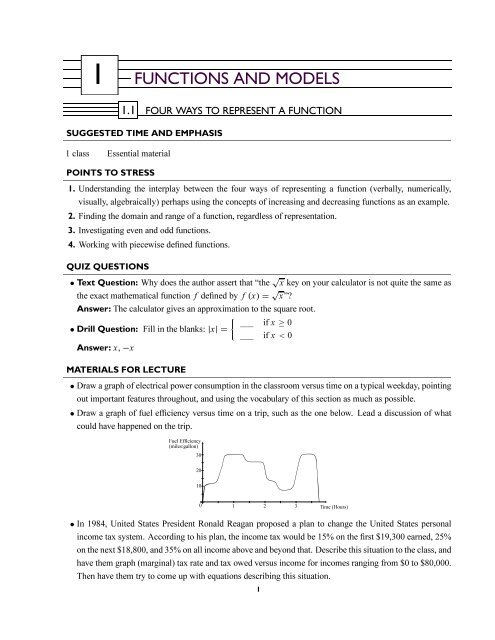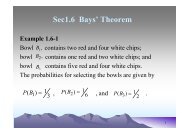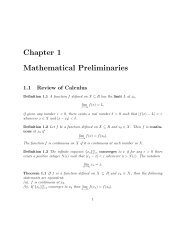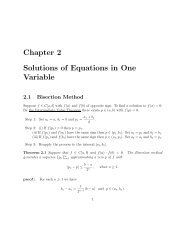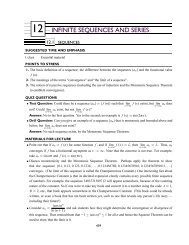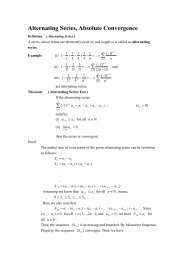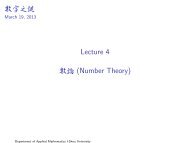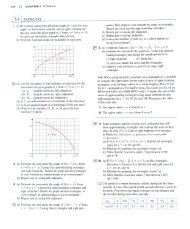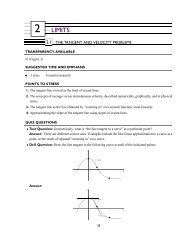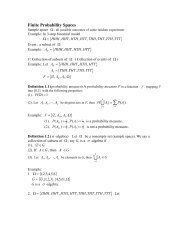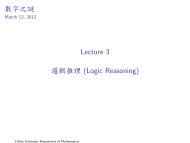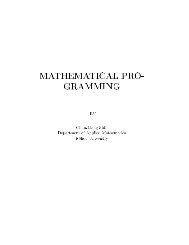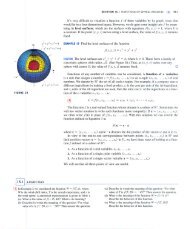1 FUNCTIONS AND MODELS
1 FUNCTIONS AND MODELS
1 FUNCTIONS AND MODELS
You also want an ePaper? Increase the reach of your titles
YUMPU automatically turns print PDFs into web optimized ePapers that Google loves.
1 <strong>FUNCTIONS</strong> <strong>AND</strong> <strong>MODELS</strong><br />
1.1 FOUR WAYS TO REPRESENT A FUNCTION<br />
SUGGESTED TIME <strong>AND</strong> EMPHASIS<br />
1 class Essential material<br />
POINTS TO STRESS<br />
1. Understanding the interplay between the four ways of representing a function (verbally, numerically,<br />
visually, algebraically) perhaps using the concepts of increasing and decreasing functions as an example.<br />
2. Finding the domain and range of a function, regardless of representation.<br />
3. Investigating even and odd functions.<br />
4. Working with piecewise defined functions.<br />
QUIZ QUESTIONS<br />
• Text Question: Why does the author assert that “the √ x key on your calculator is not quite the same as<br />
the exact mathematical function f defined by f (x) = √ x”?<br />
Answer: The calculator gives an approximation to the square root.<br />
{ ___ if x ≥ 0<br />
• Drill Question: Fill in the blanks: |x| =<br />
___ if x < 0<br />
Answer: x, −x<br />
MATERIALS FOR LECTURE<br />
• Draw a graph of electrical power consumption in the classroom versus time on a typical weekday, pointing<br />
out important features throughout, and using the vocabulary of this section as much as possible.<br />
• Draw a graph of fuel efficiency versus time on a trip, such as the one below. Lead a discussion of what<br />
could have happened on the trip.<br />
Fuel Efficiency<br />
(miles/gallon)<br />
30<br />
20<br />
10<br />
0 1 2 3 Time (Hours)<br />
• In 1984, United States President Ronald Reagan proposed a plan to change the United States personal<br />
income tax system. According to his plan, the income tax would be 15% on the first $19,300 earned, 25%<br />
on the next $18,800, and 35% on all income above and beyond that. Describe this situation to the class, and<br />
have them graph (marginal) tax rate and tax owed versus income for incomes ranging from $0 to $80,000.<br />
Then have them try to come up with equations describing this situation.<br />
1
CHAPTER 1<br />
<strong>FUNCTIONS</strong> <strong>AND</strong> <strong>MODELS</strong><br />
• In the year 2000, Presidential candidate Steve Forbes proposed a “flat tax” model: 0% on the first $36,000<br />
and 17% on the rest. Have the students do the same analysis, and compare the two models. As an extension,<br />
perhaps have the students look at a current tax table and draw similar graphs.<br />
WORKSHOP/DISCUSSION<br />
• Present graphs of even and odd functions, such as sin x, cosx + x 2 , and cos (sin x), and check with the<br />
standard algebraic tests.<br />
• Start with a table of values for a function f , such as the following:<br />
x 0 1 2 3 4<br />
f (x) 0 0.5 2 4.5 8<br />
First, have the class describe the behavior of the function in words, trying to elicit the information that the<br />
function is increasing, and that its rate of increase is also increasing. Then, have them try to extrapolate<br />
the function in both directions, debating whether or not the function is always positive and increasing. Plot<br />
the points and connect the dots, then have them try to concoct a formula (not necessarily expecting them<br />
to succeed).<br />
{ √ x if x is rational<br />
• Discuss the domain and range of a function such as f (x) =<br />
0 if x is irrational<br />
Also talk about why f is neither increasing nor decreasing for x > 0. Stress that when dealing with new<br />
sorts of functions, it becomes important to know the precise mathematical definitions of such terms.<br />
• Define “difference quotient” as done in the text. Define f (x) = x 3 ,andshowthat<br />
f (a + h) − f (a)<br />
= 3a 2 + 3ah + h 2 . This example both reviews algebra skills and foreshadows future<br />
h<br />
calculations.<br />
GROUP WORK 1: Every Picture Tells a Story<br />
Put the students in groups of four, and have them work on the exercise. If there are questions, encourage them<br />
to ask each other before asking you. After going through the correct matching with them, have each group<br />
tell their story to the class and see if it fits the remaining graph.<br />
Answers: 1. (b) 2. (a) 3. (c) 4. The roast beef was cooked in the morning and put in the refrigerator<br />
in the afternoon.<br />
GROUP WORK 2: Finding a Formula<br />
Make sure that the students know the equation of a circle with radius r, and that they remember the notation<br />
for piecewise-defined functions. Split the students into groups of four. In each group, have half of the students<br />
work on each problem first, and then have them check each other’s work. If the students find these problems<br />
difficult, have them work together on each problem.<br />
⎧<br />
⎧<br />
x + 4 if x ≤−2<br />
⎪⎨ −x − 2 if x ≤−2<br />
⎪⎨ 2 if−2 < x ≤ 0<br />
Answers: 1. f (x) = x + 2 if−2 < x ≤ 0 2. g(x) = √<br />
⎪⎩<br />
4 − x 2 if 0 < x ≤ 2<br />
2 if x > 0<br />
⎪⎩<br />
x − 2 if x > 2<br />
2
SECTION 1.1<br />
FOUR WAYS TO REPRESENT A FUNCTION<br />
HOMEWORK PROBLEMS<br />
Core Exercises: 2, 10, 18, 19, 21, 24, 28, 51, 61<br />
Sample Assignment: 2, 4, 6, 10, 13, 16, 18, 19, 20, 21, 24, 28, 51, 57, 61<br />
Exercise D A N G<br />
2 ×<br />
4 × ×<br />
6 ×<br />
10 × ×<br />
13 ×<br />
16 × ×<br />
18 ×<br />
19 × ×<br />
Exercise D A N G<br />
20 × ×<br />
21 ×<br />
24 ×<br />
28 ×<br />
51 ×<br />
57 ×<br />
61 ×<br />
3
GROUP WORK 1, SECTION 1.1<br />
Every Picture Tells a Story<br />
One of the skills you will be learning in this course is the ability to take a description of a real-world occurrence,<br />
and translate it into mathematics. Conversely, given a mathematical description of a phenomenon, you<br />
will learn how to describe what is happening in plain language. Here follow four graphs of temperature versus<br />
time and three stories. Match the stories with the graphs. When finished, write a similar story that would<br />
correspond to the final graph.<br />
T<br />
T<br />
Graph 1<br />
t<br />
Graph 2<br />
t<br />
T<br />
T<br />
t<br />
t<br />
Graph 3<br />
Graph 4<br />
(a) I took my roast beef out of the freezer at noon, and left it on the counter to thaw. Then I cooked it in the<br />
oven when I got home.<br />
(b) I took my roast beef out of the freezer this morning, and left it on the counter to thaw. Then I cooked it in<br />
the oven when I got home.<br />
(c) I took my roast beef out of the freezer this morning, and left it on the counter to thaw. I forgot about it,<br />
and went out for Chinese food on my way home from work. I put it in the refrigerator when I finally got<br />
home.<br />
4
GROUP WORK 2, SECTION 1.1<br />
Finding a Formula<br />
Find formulas for the following functions:<br />
1.<br />
y<br />
1<br />
0<br />
1<br />
x<br />
2.<br />
y<br />
1<br />
0<br />
r=2<br />
1<br />
x<br />
5
1.2 MATHEMATICAL <strong>MODELS</strong>: A CATALOG OF ESSENTIAL <strong>FUNCTIONS</strong><br />
TRANSPARENCY AVAILABLE<br />
#1 (Figure 12)<br />
SUGGESTED TIME <strong>AND</strong> EMPHASIS<br />
1 class Recommended material<br />
POINTS TO STRESS<br />
1. The modeling process: developing, analyzing, and interpreting a mathematical model.<br />
2. Classes of functions: linear, power, rational, algebraic, trigonometric, exponential and transcendental<br />
functions. Include the special characteristics of each class of functions.<br />
QUIZ QUESTIONS<br />
• Text Question: What is the difference between a power function x n with n = 3 and a cubic function?<br />
Answer: A cubic function can have lower order terms, whereas a power function has just one term.<br />
• Drill Question: Classify each function graphed below as a power function, root function, polynomial,<br />
rational function, algebraic function, or trigonometric function. Explain your reasoning.<br />
y<br />
y<br />
y<br />
10<br />
4<br />
4<br />
2<br />
2<br />
5<br />
_2 _1 0 1 2 x<br />
_2<br />
_2 _1 1 2 x<br />
_2<br />
_5 _4 _3 _2 _1 0 1 2 3 4<br />
_5<br />
5<br />
x<br />
_4<br />
Answer: Polynomial, trigonometric, trigonometric<br />
_4<br />
_10<br />
MATERIALS FOR LECTURE<br />
• Show that linear functions have constant differences in y-values for equally spaced x-values. This example<br />
illustrates the point:<br />
Linear function (difference=1.2)<br />
x f (x)<br />
−2 −2.0<br />
0 −0.8<br />
2 0.4<br />
4 1.6<br />
• Discuss the shape, symmetries, and general “flatness” near 0 of the power functions x n for various values<br />
of n. Similarly discuss n√ x for n even and n odd. A blackline master is provided at the end of this section,<br />
before the group work handouts.<br />
• If Exercises 18–22 are to be assigned, Exercise 17 can be done in class (with part (c) being discussed in the<br />
context of the technology the students have available). Attached is a guide to using a graphing calculator<br />
6
SECTION 1.2<br />
MATHEMATICAL <strong>MODELS</strong>: A CATALOG OF ESSENTIAL <strong>FUNCTIONS</strong><br />
to do regression analysis. The guide was specifically written for the TI-85, but students with various other<br />
calculators may also find it helpful.<br />
WORKSHOP/DISCUSSION<br />
• Have the students graph 2 x ,sinx, sin2 x ,and2 sin x . Discuss why the latter two look the way that they<br />
do, then discuss the relationship among the graphs of f (x) = 2 x , g (x) = (0.5) x , h (x) = 2 −x ,and<br />
k (x) = 4 x .<br />
• Figure 17 shows examples of a noncontinuous function and a nondifferentiable function, both expressible<br />
as simple formulas. Discuss these curves with the students, trying to get them to describe the ideas of a<br />
break in a graph and a cusp.<br />
GROUP WORK 1: Rounding the Bases<br />
On the board, review how to compute the percentage error when estimating π by 22 7<br />
.(Answer:0.04%) Have<br />
them work on the problem in groups. If a group finishes early, have them look at h(7) and h(10) to see how<br />
fast the error grows. Exponential functions will be covered in more detail in Chapter 7.<br />
Answers: 1. 17.811434627, 17, 4.56% 2. 220.08649875, 201, 8.67% 3. 45.4314240633, 32, 29.56%<br />
GROUP WORK 2: The Small Shall Grow Large<br />
If a group finishes early, ask them to similarly compare x 3 and x 4 .<br />
Answers: 1. x 6 ≥ x 8 for −1 ≤ x ≤ 1 2. x 3 ≥ x 5 for −∞ < x ≤−1, 0 ≤ x ≤ 1 3. x 3 ≥ x 105 for<br />
−∞ < x ≤−1, 0 ≤ x ≤ 1. If the exponents are both even, the answer is the same as for Problem 1, if the<br />
exponents are both odd, the answer is the same as for Problem 2.<br />
GROUP WORK 3: Fun with Fourier<br />
This activity should be given before Fourier series are discussed in class. This activity will get students<br />
looking at combinations of sine curves, while at the same time foreshadowing the concepts of infinite series<br />
and Fourier series.<br />
Answers:<br />
1. No<br />
2. S (x) =<br />
{ 1 if−2π ≤ x < −π or 0 ≤ x < π<br />
−1 if−π ≤ x < 0orπ ≤ x ≤ 2π<br />
4<br />
π<br />
3. Answers will vary. sin x has the advantage of being an odd function, like the square wave. Some<br />
4<br />
students will believe that<br />
π<br />
cos x has the same y-intercept as the square wave. This provides a good<br />
opportunity to point out that the square wave has no y-intercept — what happens just to the right of x = 0<br />
is different from what happens just to the left of x = 0.<br />
7
4.<br />
)<br />
4<br />
π<br />
(sin x + 1 3 sin 3x + 1 5 sin 5x<br />
CHAPTER 1<br />
<strong>FUNCTIONS</strong> <strong>AND</strong> <strong>MODELS</strong><br />
y<br />
1<br />
_6 _4 _2 0 2 4 6 x<br />
5.<br />
(<br />
4 sin 3x<br />
sin x +<br />
π<br />
3<br />
+<br />
sin 5x<br />
5<br />
+<br />
sin 7x<br />
7<br />
+<br />
sin 9x<br />
9<br />
+<br />
_1<br />
sin 11x<br />
11<br />
+<br />
sin 13x<br />
13<br />
+<br />
sin 15x<br />
15<br />
+<br />
sin 17x<br />
17<br />
+<br />
)<br />
sin 19x<br />
19<br />
y<br />
1<br />
_2¹<br />
_¹<br />
¹ 2¹<br />
x<br />
_1<br />
6. y<br />
¹/2<br />
_2¹ _¹ 0<br />
_¹/2<br />
¹ 2¹<br />
x<br />
USING A GRAPHING CALCULATOR TO DO REGRESSION ANALYSIS<br />
The following instructions assume the use of a TI-85 calculator.<br />
• Under the STAT menu select EDIT.<br />
• Choose desired lists for x-andy-coordinates.<br />
• Enter the x-andy-coordinates of the data.<br />
• In graph mode, set approximate ranges so points can be viewed. Erase or deselect all functions.<br />
• In default window, choose a regression model:<br />
• ExpR (Exponential regression)<br />
• LinR (Linear regression)<br />
• LnR (Logarithmic regression)<br />
• P2Reg (Quadratic regression)<br />
• P3Reg (Cubic regression)<br />
• P4Reg (Quartic regression)<br />
• Under STAT mode, select DRAW.<br />
• Select SCAT to plot data points.<br />
• Select DRREG to plot the regression model.<br />
• Move cursor along regression plot to get approximations for interpolation.<br />
8
SECTION 1.2<br />
MATHEMATICAL <strong>MODELS</strong>: A CATALOG OF ESSENTIAL <strong>FUNCTIONS</strong><br />
HOMEWORK PROBLEMS<br />
Core Exercises: 4, 8, 15, 18, 21, 23<br />
Sample Assignment: 4, 8, 9, 10, 12, 15, 18, 19, 21, 23, 25<br />
Exercise D A N G<br />
4 × ×<br />
8 × ×<br />
9 ×<br />
10 × ×<br />
12 × ×<br />
15 × ×<br />
18 × × ×<br />
19 × ×<br />
21 × × ×<br />
23 × × × ×<br />
25 × ×<br />
9
CHAPTER 1<br />
<strong>FUNCTIONS</strong> <strong>AND</strong> <strong>MODELS</strong><br />
y<br />
1<br />
y<br />
1<br />
y<br />
1<br />
0<br />
x<br />
1<br />
x<br />
0 1 x<br />
0 1<br />
x 2 x 3<br />
x<br />
y<br />
1<br />
y<br />
1<br />
y<br />
1<br />
0 1 x<br />
0 1 x<br />
0 1<br />
x 4 x 5 x 6<br />
x<br />
y<br />
1<br />
y<br />
1<br />
y<br />
1<br />
0<br />
x<br />
1<br />
x<br />
0 1 x<br />
0 1<br />
√ x 3√ x<br />
x<br />
y<br />
1<br />
y<br />
1<br />
y<br />
1<br />
0 1 x<br />
0 1 x<br />
0 1<br />
4√ x 5√ x 6√ x<br />
x<br />
10
GROUP WORK 1, SECTION 1.2<br />
Rounding the Bases<br />
1. For computational efficiency and speed, we often round off constants in equations. For example, consider<br />
the linear function<br />
f (x) = 3.137619523x + 2.123337012<br />
In theory, it is very easy and quick to find f (1), f (2), f (3), f (4), and f (5). In practice, most people<br />
doing this computation would probably substitute<br />
f (x) = 3x + 2<br />
unless a very accurate answer is called for. For example, compute f (5) both ways to see the difference.<br />
The actual value of f (5):<br />
The “rounding” estimate:<br />
The percentage error:<br />
__________<br />
__________<br />
__________<br />
2. Now consider<br />
g (x) = 1.12755319x 3 + 3.125694x 2 + 1<br />
Again, one is tempted to substitute g (x) = x 3 + 3x 2 + 1.<br />
The actual value of g (5):<br />
The “rounding” estimate:<br />
The percentage error:<br />
__________<br />
__________<br />
__________<br />
3. It turns out to be very dangerous to similarly round off exponential functions, due to the nature of their<br />
growth. For example, let’s look at the function<br />
h (x) = (2.145217198123) x<br />
One may be tempted to substitute h (x) = 2 x for this one. Once again, look at the difference between<br />
these two functions.<br />
The actual value of h (5): __________<br />
The “rounding” estimate:<br />
The percentage error:<br />
__________<br />
__________<br />
11
GROUP WORK 2, SECTION 1.2<br />
The Small Shall Grow Large<br />
1. For what values of x is x 6 ≥ x 8 ? For what values is x 6 ≤ x 8 ?<br />
2. For what values of x is x 3 ≥ x 5 ?<br />
3. For what values of x is x 3 ≥ x 105 ? Can you generalize your results?<br />
12
GROUP WORK 3, SECTION 1.2<br />
Foreshadowing Fourier<br />
The following function S (x) is called a “square wave”.<br />
y<br />
1<br />
_2¹ _¹ 0<br />
_1<br />
¹ 2¹<br />
x<br />
1. Can you find a function on your calculator which has the given graph?<br />
2. Write a formula that has this graph for −2π ≤ x ≤ 2π.<br />
3. Which of the functions sin x and cos x gives a better approximation to S (x)?<br />
4. Select the function from among the following which gives the best approximation to the square wave:<br />
sin x,sinx + sin 3x,sinx + 1 2 sin 3x,sinx + 1 3 sin 3x, and sin x + 1 4<br />
sin 3x.<br />
5. Find the integer n which makes f (x) = sin x + 1 3 sin 3x + n 1 sin 5x the best possible approximation to the<br />
square wave.<br />
13
Foreshadowing Fourier<br />
6. A Fourier approximation of a function is an approximation of the form<br />
F (x) = a 0 + a 1 cos x + b 1 sin x + a 2 cos 2x + b 2 sin 2x +···+a n cos nx + b n sin nx<br />
You have just discovered the Fourier approximation to S (x) with three terms. Find the Fourier<br />
approximation to S (x) with ten terms, and sketch its graph.<br />
7. The following expressions are Fourier approximations to a different function, T (x):<br />
T (x) ≈ sin x<br />
T (x) ≈ sin x − 1 2<br />
sin 2x<br />
T (x) ≈ sin x − 1 2 sin 2x + 1 3<br />
sin 3x<br />
T (x) ≈ sin x − 1 2 sin 2x + 1 3 sin 3x − 1 4<br />
sin 4x<br />
T (x) ≈ sin x − 1 2 sin 2x + 1 3 sin 3x − 1 4 sin 4x + 1 5<br />
sin 5x<br />
Sketch T (x).<br />
14
1.3 NEW <strong>FUNCTIONS</strong> FROM OLD <strong>FUNCTIONS</strong><br />
SUGGESTED TIME <strong>AND</strong> EMPHASIS<br />
1 class Essential material<br />
POINTS TO STRESS<br />
1. The mechanics and geometry of transforming functions.<br />
2. The mechanics and geometry of adding, subtracting, multiplying, and dividing functions.<br />
3. The mechanics and geometry of composing functions.<br />
QUIZ QUESTIONS<br />
( )<br />
• Text Question: Label the following graphs: f (x), 1 2 f (x) , f 12<br />
x .<br />
y<br />
1<br />
y<br />
1<br />
y<br />
1<br />
0 2 x<br />
0 2 x<br />
0 2 x<br />
( )<br />
Answer: 1 2 f (x), f 12<br />
x , f (x)<br />
• Drill Question: How can we construct the graph of y = | f (x)| from the graph of y = f (x)? Explain<br />
in words, and demonstrate with the graph of y = x 2 − 4.<br />
Answer: We leave the positive values of f (x) alone, and reflect the negative values about the x-axis.<br />
y<br />
y<br />
2<br />
2<br />
0<br />
1 x<br />
0<br />
1 x<br />
y = x 2 − 4<br />
15<br />
y = ∣ ∣x 2 − 4 ∣ ∣
CHAPTER 1<br />
<strong>FUNCTIONS</strong> <strong>AND</strong> <strong>MODELS</strong><br />
MATERIALS FOR LECTURE<br />
• Using f (x) = x sin x, explore graphs of f (x + 2), f (x) + 2, − f (x), f (−x), | f (x)|. Note why<br />
f (−x) = f (x).<br />
• Graph f (x) = sin (√ x ) and g (x) = √ sin x. Draw the relevant “arrow diagrams” and then write them in<br />
the forms l ◦ k and k ◦ l. Then discuss reasons for the differences in their graphs.<br />
Answer: See the text for sample arrow diagrams. f is a sine function whose argument grows larger more<br />
and more slowly as we move away from the origin. g is a root function whose argument oscillates, causing<br />
g to oscillate as well.<br />
WORKSHOP/DISCUSSION<br />
• Using f (x) = 1/x 2 and g (x) = cos x, compute the domains of f + g, f/g, g/f , f ◦ g, andg ◦ f ,and<br />
the range of g ◦ f . Pay particular attention to the domain of g/f , as many students will think it is R.<br />
• Do the following problem with the students:<br />
y<br />
y=f(x)<br />
1<br />
0<br />
1<br />
x<br />
From the graph of y = f (x) =−x 2 + 2 shown above, compute f ◦ f at x =−1, 0, and 1. First do it<br />
graphically (as in Exercises 59 and 60), then algebraically.<br />
• TEC Using TEC or a graphing calculator, have the students graph the following functions, where<br />
f (x) = x + x 2 , first guessing what each graph will look like.<br />
1. f (2x) 4. −2 f (x) 7. f (x) + 2<br />
(<br />
2. f 12<br />
x)<br />
5. f (x − 2) 8. 2 f (2x)<br />
(<br />
3. 2 f (x) 6. f (x) − 2 9. 2 f 12<br />
x)<br />
GROUP WORK 1: Which is the Original?<br />
Answers: 1. 2 f (x + 2),2f (x), f (2x), f (x + 2), f (x) 2. 2 f (x), f (x), f (x + 2), f (2x),2f (x + 2)<br />
GROUP WORK 2: Label Label Label, I Made It Out of Clay<br />
Some of these transformations were not covered directly in the book. If the students are urged not to give<br />
up, and to use the process of elimination and testing individual points, they should be able to complete this<br />
activity.<br />
Answers: 1. (d) 2. (a) 3. (f) 4. (e) 5. (i) 6. (j) 7. (b) 8. (c) 9. (g) 10. (h)<br />
16
SECTION 1.3<br />
NEW <strong>FUNCTIONS</strong> FROM OLD <strong>FUNCTIONS</strong><br />
GROUP WORK 3: It’s More Fun to Compute<br />
Each group gets one copy of the graph. During each round, one representative from each group stands,<br />
and one of the questions below is asked. The representatives write their answer down, and all display their<br />
answers at the same time. Each representative has the choice of consulting with their group or not. A correct<br />
solo answer is worth two points, and a correct answer after a consult is worth one point.<br />
Answers: 1. 0 2. 0 3. 1 4. 5 5. 1 6. 1 7. 1 8. 0 9. 2 10. 1 11. 1 12. 1<br />
HOMEWORK PROBLEMS<br />
Core Exercises: 1, 5, 10, 29, 31, 39, 50, 51, 54, 60<br />
Sample Assignment: 1, 5, 6, 10, 17, 26, 28, 29, 31, 39, 42, 50, 51, 54, 56, 57, 59, 60, 62, 63<br />
Exercise D A N G<br />
1 ×<br />
5 ×<br />
6 × ×<br />
10 ×<br />
17 ×<br />
26 × ×<br />
28 × ×<br />
29 ×<br />
31 ×<br />
39 ×<br />
Exercise D A N G<br />
42 ×<br />
50 × ×<br />
51 × ×<br />
54 × ×<br />
56 × ×<br />
57 × × ×<br />
59 ×<br />
60 × ×<br />
62 ×<br />
63 ×<br />
17
GROUP WORK 1, SECTION 1.3<br />
Which is the Original?<br />
Below are five graphs. One is the graph of a function f (x) and the others include the graphs of 2 f (x),<br />
f (2x), f (x + 2),and2f (x + 2). Determine which is the graph of f (x) and match the other functions with<br />
their graphs.<br />
1.<br />
y<br />
y<br />
y<br />
1<br />
1<br />
1<br />
0 1 x<br />
0 1 x<br />
0 1 x<br />
Graph 1 Graph 2 Graph 3<br />
y<br />
y<br />
1<br />
1<br />
0<br />
1 x<br />
0<br />
1 x<br />
2.<br />
y<br />
Graph 4<br />
y<br />
Graph 5<br />
y<br />
1<br />
1<br />
1<br />
0 1 x<br />
0 1 x<br />
0 1 x<br />
Graph 1 Graph 2 Graph 3<br />
y<br />
y<br />
1<br />
1<br />
0<br />
1 x<br />
0<br />
1 x<br />
Graph 4<br />
Graph 5<br />
18
This is a graph of the function f (x):<br />
GROUP WORK 2, SECTION 1.3<br />
Label Label Label, I Made it Out of Clay<br />
y<br />
5<br />
0<br />
2<br />
x<br />
Give each graph below the correct label from the following:<br />
(a) f (x + 3) (b) f (x − 3) (c) f (2x) (d) 2 f (x) (e) | f (x)|<br />
(f) f (|x|) (g) 2 f (x) − 1 (h) f (2x) + 2 (i) f (x) − x (j) 1/f (x)<br />
y<br />
y<br />
y<br />
y<br />
5<br />
5<br />
5<br />
5<br />
0 2<br />
x<br />
0 2<br />
x<br />
0 2<br />
x<br />
0 2<br />
x<br />
Graph 1 Graph 2 Graph 3 Graph 4<br />
y<br />
y<br />
y<br />
y<br />
5<br />
5<br />
5<br />
5<br />
0 2<br />
x<br />
0 2<br />
x<br />
0 2<br />
x<br />
0 2<br />
x<br />
Graph 5 Graph 6 Graph 7 Graph 8<br />
y<br />
y<br />
5<br />
5<br />
0 2<br />
x<br />
0 2<br />
x<br />
Graph 9 Graph 10<br />
19
Using the graph below, find the following quantities.<br />
GROUP WORK 3, SECTION 1.3<br />
It’s More Fun to Compute<br />
1. ( f ◦ g)(5) 5. (g ◦ g)(5) 9. (g ◦ f )(1)<br />
2. (g ◦ f )(5) 6. (g ◦ g)(−3) 10. ( f ◦ f ◦ g)(4)<br />
3. ( f ◦ g)(0) 7. (g ◦ g)(−1) 11. (g ◦ f ◦ f )(4)<br />
4. ( f ◦ f )(5) 8. ( f ◦ g)(1) 12. ( f ◦ g ◦ f )(4)<br />
y<br />
5<br />
4<br />
3<br />
f<br />
2<br />
1<br />
g<br />
0<br />
_5 _4 _3 _2 _1 1 2 3 4 5<br />
x<br />
_1<br />
_2<br />
_3<br />
_4<br />
_5<br />
20
1.4 GRAPHING CALCULATORS <strong>AND</strong> COMPUTERS<br />
SUGGESTED TIME <strong>AND</strong> EMPHASIS<br />
1<br />
2<br />
–1 class Optional material (If unassigned, students should be encouraged to read this self-contained<br />
section on their own.)<br />
POINTS TO STRESS<br />
1. When graphing an arbitrary function, some viewing windows are more appropriate than others, depending<br />
on the context of the inquiry and some analysis of the actual equation.<br />
2. Some functions don’t have any single viewing window that will give all the important details of the<br />
function.<br />
3. One can use zoom and trace features to obtain estimates of solutions to difficult algebraic equations.<br />
4. Graphing calculators can give misleading or wrong answers.<br />
QUIZ QUESTIONS<br />
• Text Question: Why is it true that “The solutions of the equation cos x = x are the x-coordinates of the<br />
points of intersection of the curves y = cos x and y = x”?<br />
Answer: If y = cos x and y = x,wecanusesubstitutiontosetx = y = cos x.<br />
• Drill Question: Find all solutions of the equation x 3 − 10x 2 − 4 = 0 correct to at least two decimal<br />
places.<br />
Answer: x ≈ 10.0397<br />
MATERIALS FOR LECTURE<br />
• Caution students to take care when using their calculators, particularly when choosing a viewing window.<br />
The following are features of a function that are difficult to determine solely from computer graphics:<br />
• End behavior. For example, f (x) = log 10 x<br />
100 sin x<br />
• Certain asymptotes, such as oblique asymptotes. For example, f (x) = 3x + 2 + 5√ , x > 2 x<br />
• The effects of parameters. For example, f (x) = sin ( Ax b)<br />
• Hidden roots. For example, the roots of f (x) = x 4 − 0.001x<br />
• Domains and ranges. For example, the domain of √ sin (x + cos x), the range of sin x<br />
x<br />
• Have the class experiment with f (x) = cos<br />
(x + 1 )<br />
x 2 near x = 0, and also for large values of x.<br />
• Attempt to graph f (x) = √ x − 2 √ x − 4, and to find its domain. Certain packages or calculators (like<br />
the TI-89, Maple, and Mathematica) will graph it incorrectly, with domain (−∞, 2) ∪ (4, ∞). Discuss<br />
why some software makes this error.<br />
Answer: For x < 2, each of these algebra packages converts both multiplicands into imaginary numbers,<br />
multiplies them, and then converts the product back into a real number. This process is invalid in the<br />
context of real-valued functions.<br />
21
CHAPTER 1<br />
<strong>FUNCTIONS</strong> <strong>AND</strong> <strong>MODELS</strong><br />
• Demonstrate the use of a calculator as an investigative tool (for example, to explore a family of functions<br />
like f (x) = Qx + cos x by graphing with Q = 0.5, 0.75, 0.95,1,and1.1). Discuss the meaning of<br />
“parameter” using Q as an example. Be sure to note that when Q < 1, the function has “peaks and<br />
valleys” (local maxima and minima) and when Q > 1 the function is always increasing.<br />
Answer:<br />
y<br />
y<br />
y<br />
1<br />
1<br />
1<br />
0<br />
2 x<br />
0<br />
2 x<br />
0<br />
2 x<br />
Q = 0.5<br />
y<br />
Q = 0.75<br />
y<br />
Q = 0.95<br />
1<br />
1<br />
0<br />
2 x<br />
0<br />
2 x<br />
Q = 1<br />
Q = 1.1<br />
WORKSHOP/DISCUSSION<br />
• Pose the question, “What happens to cos x − 1 as x gets close to zero?” Show how the strategy of<br />
x<br />
substituting x = 0 fails. Investigate this question numerically, and then by graphing. Follow up with the<br />
function cos x − 1<br />
x 2 .<br />
Answer: As x gets close to zero, the value of cos x − 1 gets close to zero. as x gets close to zero, the<br />
x<br />
value of cos x − 1<br />
x 2 gets close to − 1 2 .<br />
• Have the students try to figure out what the graph of f (x) = [x + 0.05 cos (20x)] 2 looks like near x = 0<br />
by experimenting with viewing windows. Then have them try to explain why their picture makes sense.<br />
• Have the students first determine where f (x) = x 3 − 50x 2 is larger than x 2 .Pointoutthatitiseasierto<br />
use some algebra to solve this problem than to use a calculator<br />
Answer: x > 51<br />
• Have the students first guess the shape of f (x) = √ sin x, and then graph it. Ask how they should have<br />
known it would be periodic.<br />
22
SECTION 1.4<br />
GRAPHING CALCULATORS <strong>AND</strong> COMPUTERS<br />
GROUP WORK 1: Short- and Long-Term Behavior<br />
Before handing this exercise out, show what is meant by “long-term behavior”.<br />
Part of the idea of this exercise is getting the students to explore and play with functions (even unfamiliar ones)<br />
on their calculators. Encourage them to try varying the functions on the worksheet, and see what happens.<br />
Answers: 1. (a) f (x) →∞as x →∞ (b) x = 0, x ≈−0.877 2. (a) g (x) →∞as x →∞(g is<br />
asymptotic to y = 6x) (b) None 3. (a) h (x) →∞as x →∞ (b) x = 0, ± √ 3 4. (a) j (x) → 1as<br />
x →∞ (b) None 5. (a) k (x) →−∞as x →∞ (b) x ≈ 0.4027, 0.9952, 1.923 6. (a) l (x) →−∞<br />
as x →∞ (b) x = 0<br />
GROUP WORK 2: Just Two Solutions<br />
This is an extension of Exercise 24. It is a difficult exercise, and the students may require some guidance.<br />
Before handing out the hint sheet, have the students try to solve this problem on their own: “Consider the<br />
equation cos x = mx. Find a value of m such that this equation has exactly two solutions.” After they have<br />
worked on the problem, and are clear on what they are trying to find, hand out the hint sheet. Don’t let them<br />
hang too long! Conclude by discussing how the line y = mx that yields exactly two solutions is called tangent<br />
to the curve y = cos x. Explain that soon we will learn how to find the equation of such a line. This is a<br />
good example to bring back once they have covered derivatives of trigonometric functions in Section 3.5.<br />
At that point, they will wind up having to solve the equation x =−cot x. Revisit the problem again after<br />
covering Newton’s method in Section 4.9, at which point they will finally have a way of approximating m to<br />
any desired accuracy.<br />
Answers:1.,3.,7.<br />
y 1 2<br />
1<br />
3<br />
4<br />
5<br />
2. 1, 3<br />
5. m ≈±0.33651<br />
6. Symmetry<br />
_8 _6 _4 _2 0 2 4 6 8 x<br />
_1<br />
HOMEWORK PROBLEMS<br />
Core Exercises: 5, 8, 19, 22, 26, 29<br />
Sample Assignment: 5, 8, 15, 18, 19, 22, 24, 26, 27, 29, 35<br />
Exercise D A N G<br />
5 ×<br />
8 ×<br />
15 ×<br />
18 ×<br />
19 ×<br />
22 × ×<br />
Exercise D A N G<br />
24 ×<br />
26 × ×<br />
27 × ×<br />
29 × ×<br />
35 ×<br />
23
GROUP WORK 1, SECTION 1.4<br />
Short- and Long-Term Behavior<br />
For each of the following functions, (a) describe the long term behavior of the function, and (b) locate the<br />
zeros,ifany.<br />
1. f (x) = sin x + x 2<br />
2. g (x) = 6x + 1 x = 6x2 + 1<br />
x<br />
3. h (x) = x3 − 3x<br />
x + 7<br />
4. j (x) = 2 −1/x6<br />
5. k (x) = x 5 − 2x 4 − x 2 + 3x − 1.01 x<br />
6. l (x) = Qx + sin x for Q = 0.32, 0.9, and 1.1 What are the differences among these three functions?<br />
24
GROUP WORK 2, SECTION 1.4<br />
Just Two Solutions (Hint Sheet)<br />
Problem: Find a value of m such that the equation cos x = mx has exactly two solutions.<br />
1. Very carefully, draw graphs of the following three functions below: y = cos x, y = x, y = 1 5 x.<br />
y<br />
1<br />
_8 _6 _4 _2<br />
2<br />
4 6 8<br />
x<br />
_1<br />
2. From the graphs, determine how many solutions the equation has for m = 1 and for m = 1 5 .<br />
3. Add a sketch of y = mx onto your picture for Problem 1, where m is chosen so that the equation<br />
cos x = mx has exactly two solutions. You can do this without actually computing m.<br />
4. Use your sketch to estimate the correct value of m.<br />
5. Now use your graphing calculator to refine your guess. Try to get an answer correct to three decimal<br />
places.<br />
6. Why is it true that the value −m will also give exactly two solutions to cos x = mx?<br />
7. Is it possible to find a value of m such that cos x = mx has exactly three solutions? Four? n? Explain<br />
your answer by sketching y = cos x and y = mx for the relevant values of m.<br />
25
1 SAMPLE EXAM<br />
Problems marked with an asterisk (*) are particularly challenging and should be given careful consideration.<br />
1. The graph below shows the temperature of a room during a summer day as a function of time, starting at<br />
midnight.<br />
(a) Evaluate f (noon) and f (6 P.M.). State the range of f .<br />
6 12<br />
18<br />
24 t (h)<br />
(b) Where is f increasing? Decreasing?<br />
(c) Give a possible explanation for what happened at noon.<br />
(d) Give a possible explanation why f attains its minimum value at 6 A.M.<br />
2. A proposed new grain silo consists of a cylinder of height h and radius r, capped by a hemisphere.<br />
Express its volume as a function of h and r.<br />
26
CHAPTER 1<br />
SAMPLE EXAM<br />
3. The Slopps R○ trading card company has decided to put out its best line of trading cards ever: The “Famous<br />
Mathematicians” Series. Each pack of cards contains eight famous mathematicians, a mathematical<br />
puzzle, and a mathematics sticker. Naturally, you want a complete set, but you will have to buy a lot<br />
of cards because the really good ones (like the Galois, Sylvester, Hesse, Newton, and Leibniz cards) are<br />
very rare. Your local dealer will sell you an individual card, randomly selected, for 50 cents. Most people<br />
are interested in buying the packs of 8 for $2.80. When you tell the dealer you want to buy a lot of them,<br />
he offers to sell you a box (containing 10 packs) for $25, or a carton (containing 10 boxes) for $230.<br />
Let c (x) be the (least) cost of buying x cards. Note that it is acceptable to buy more than x cards if it costs<br />
less than buying exactly x cards.<br />
(a) Explain why the cheapest way to buy 6 cards is to buy a pack of 8. What is c (6)?<br />
(b) Sketchagraphofy = c (x) from x = 0tox = 24.<br />
(c) Find a formula for c (x), valid for x = 80 to x = 90.<br />
(d) If you wanted to buy 1005 cards, what is the least you would have to pay?<br />
27
CHAPTER 1<br />
<strong>FUNCTIONS</strong> <strong>AND</strong> <strong>MODELS</strong><br />
4. The following is a graph of y = f (x).<br />
y<br />
4<br />
2<br />
0<br />
2 4 6 8 x<br />
_2<br />
_4<br />
On the same axes, draw and label graphs of<br />
(a) 2 f (x + 2)<br />
(c)<br />
f (2x)<br />
y<br />
8<br />
(b) 1 2 f (−x) 2 4 6 8 x<br />
y<br />
8<br />
y<br />
8<br />
6<br />
6<br />
6<br />
4<br />
4<br />
4<br />
2<br />
2<br />
2<br />
_8<br />
_6<br />
_4<br />
_2<br />
0<br />
2 4 6 8 x<br />
_8<br />
_6<br />
_4<br />
_2<br />
0<br />
_8<br />
_6<br />
_4<br />
_2<br />
0<br />
2 4 6 8 x<br />
_2<br />
_2<br />
_2<br />
_4<br />
_4<br />
_4<br />
_6<br />
_6<br />
_6<br />
_8<br />
_8<br />
_8<br />
(d) 2 f (2x − 2)<br />
(e) f (2x) − 2<br />
y<br />
y<br />
8<br />
8<br />
6<br />
6<br />
4<br />
4<br />
2<br />
2<br />
_8<br />
_6<br />
_4<br />
_2<br />
0<br />
2 4 6 8 x<br />
_8<br />
_6<br />
_4<br />
_2<br />
0<br />
2 4 6 8 x<br />
_2<br />
_2<br />
_4<br />
_4<br />
_6<br />
_6<br />
_8<br />
_8<br />
28
CHAPTER 1<br />
SAMPLE EXAM<br />
5. Use the given graphs of f and g to evaluate each expression, or explain why it is undefined.<br />
(a) ( f ◦ g)(2)<br />
(b) (g ◦ f )(2)<br />
(c) ( f ◦ f )(2)<br />
(d) (g ◦ g)(2)<br />
(e) ( f + g)(2)<br />
(f) ( f/g)(2)<br />
29
CHAPTER 1<br />
<strong>FUNCTIONS</strong> <strong>AND</strong> <strong>MODELS</strong><br />
6. Find a formula that describes the following function.<br />
y<br />
1<br />
1<br />
_2<br />
_1<br />
0 1 2<br />
x<br />
7. Let f (x) = 2.912345x 2 + 3.131579x − 0.099999<br />
(a) To simplify approximation of f , write a quadratic function g (x) with integer coefficients that closely<br />
models f (x) for −10 < x < 10.<br />
(b) Compute g (4) and f (4) .<br />
(c) Compute the error in using g (4) to approximate f (4) as a percentage of the correct answer f (4).<br />
(d) For larger values of x (say x = 10 or x = 20), would g (x) be an overestimate or an underestimate of<br />
f (x)? Justify your answer without computing specific values of f and g.<br />
30
CHAPTER 1<br />
SAMPLE EXAM<br />
8. A manufacturer hires a mathematician to come up with a function f that models the cost C of producing<br />
a alternative-music compact discs, where C is in thousands of dollars. The graph of f is given below.<br />
(a) What does f (50,000) − f (49,999) represent?<br />
(b) For what value or range of values is the cost per disc the least?<br />
(c) Give a possible explanation for the sudden increase in the curve’s slope at the end.<br />
31
1 SAMPLE EXAM SOLUTIONS<br />
1. Approximate answers are acceptable for this problem.<br />
(a) f (noon) = 87 ◦ , f (6 P.M.) = 67 ◦ , range of f is [53, 87].<br />
(b) f is increasing on (6, 12) and (20, 22); f is decreasing on (0, 6), (12, 20) and (22, 24).<br />
(c) Possible explanations for the drop in temperature at noon are a sudden thundershower, or an air conditioner<br />
being turned on.<br />
(d) A possible explanation for f attaining its minimum value at 6 A.M. is that this is just before sunrise.<br />
2. The total volume is the volume of a cylinder of height and radius r plus the volume of a hemisphere of<br />
radius r,thatis,V = πr 2 h + 2 3 πr3 .<br />
3. (a) If we buy 8 cards for $2.80, then this costs less than buying 6 individual cards at $0.50 apiece. Hence,<br />
C (6) = $2.80.<br />
(b) c<br />
10<br />
5<br />
0 3 6 9 12 15 18 21 24 x<br />
⎧<br />
⎨ 25 + 0.5 (x − 80) if 80 ≤ x ≤ 85<br />
(c) c (x) = 27.8 if86 ≤ x ≤ 88<br />
⎩<br />
27.8 + 0.5 (x − 88) if 89 ≤ x ≤ 90<br />
(d) To buy 1005 cards, the best deal is to buy one carton (800 cards), two boxes (160 cards), five packs<br />
(40 cards) and five individual cards. The total cost would be<br />
230 + 2 (25) + 5 (2.80) + 5 (0.50) = $296.50<br />
4. (a)<br />
y<br />
8<br />
(b)<br />
y<br />
1<br />
4<br />
_6 _4 _2 0 x<br />
_2<br />
0<br />
2 4 x<br />
_4<br />
_4<br />
_8<br />
32
CHAPTER 1<br />
SAMPLE EXAM SOLUTIONS<br />
(c)<br />
y<br />
(d)<br />
y<br />
(e)<br />
y<br />
2<br />
4<br />
0<br />
2 4 x<br />
0<br />
1 2 x<br />
0<br />
2 4 x<br />
_4<br />
_2<br />
_4<br />
_8<br />
_8<br />
5. (a) ( f ◦ g)(2) = f (0) = 1<br />
(b) (g ◦ f )(2) = g (3) = 1<br />
(c) ( f ◦ f )(2) = f (3) = 4<br />
(d) (g ◦ g)(2) = g (0) = 4<br />
(e) ( f + g)(2) = f (2) + g (2) = 3 + 0 = 3<br />
( ) f<br />
(f) (2) is undefined because g (2) = 0.<br />
g<br />
⎧<br />
⎨ √<br />
−x − 1 if x < −1<br />
6. f (x) = 1 − x<br />
⎩<br />
2 if −1 ≤ x ≤ 1<br />
−x + 1 if x > 1<br />
7. (a) g (x) = 3x 2 + 3x<br />
(b) g (4) = 60, f (4) = 59.023837<br />
(c) The percentage error in using g (4) as an approximation for f (4) is 100<br />
∣<br />
f (4) − g (4)<br />
g (4)<br />
∣ = 1.63%.<br />
(d) For larger values of x, g (x) is an overestimate of f (x) because the coefficient of the dominant term<br />
(x 2 )islarger.<br />
8. (a) f (50, 000) − f (49, 999) represents the cost of producing the 50,000th disc.<br />
(b) The cost per disc is cheapest for 30, 000 < a < 40, 000. This is where the slope of f is the smallest.<br />
(c) One possible explanation for the sudden increase in the curve’s slope is scarcity of materials.<br />
33


